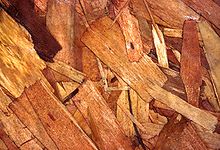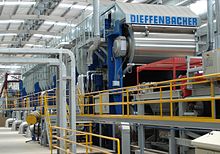Wood chipboard
Pressed wood or particle board in a broad sense are wood materials , consisting of wood shavings and a synthetic resin glue are produced by heat and pressure. Chipboard is the most widely used type of wood-based material worldwide. In addition to wood, alternative panel materials such as flax shives , bagasse and, to a lesser extent, bamboo or straw are also used.
The chipboard materials are used in furniture and interior design. Around 50% of the chipboard manufactured in Germany is made into furniture. Depending on the resistance of the glue, they are also suitable for damp rooms.
Manufacturing
The simplified production process of the chipboard is as follows:
The raw material wood (mainly softwood ) is shredded into chips by means of chippers and chippers . For the gluing and the subsequent pressing, the chips require the required moisture content (top layer 1–8%; middle layer 4–6%). Since the chips do not normally meet these requirements, they have to be dried. The drying process depends on the parameters wood type, chip size, bulk density and input moisture.
After drying, the chips are layered by machine. Coarser chips are used in the middle layer, finer ones in the top layer. Due to the layering, the chips can be glued according to their use. Gluing comprises the following process stages: production of the glue liquor, metering of the chips, as well as glue application and mixing of chips and glue.
After gluing, the chips are scattered to form a fleece . This is pressed into panels under the action of high temperatures (approx. 200 ° C). Old presses are designed as single or multi-daylight presses, but modern systems work in a continuous mode of operation, i.e. as endless belt presses. After pressing, the panels are conditioned (stored for one week to compensate for moisture and heat in the panel), trimmed and sanded.
Chipboard is mainly made from by- products of woodworking and processing.
Classification
A distinction is made between the following subspecies:
-
Flat pressed board (P1-7), commonly referred to as chipboard
- Single-layer panel
- Three-layer board
- Multilayer board
- lightweight flat press plate
-
Extrusion plate
- Extruded Tubular (ET)
- Extruded solid sheet (ES -Extruded Solid)
- Plastic-coated decorative flat pressed board (MFB - Melamine Faced Board), also known as furniture board
- Chipboard molded parts
- Coarse chipboard (OSB - Oriented Strand Board)
- Chipboard wood (LSL)
Adhesives
The adhesive systems are especially systems from various combinations of urea - melamine -, and phenol - formaldehyde - adhesives used. There are also panels bonded with polymeric isocyanate ( PMDI ). The adhesives are characterized in particular by their different water and hot water resistance and thus determine the longevity of the chipboard products.
The simplest and most common type of chipboard (not swell-resistant ) is made with the most inexpensive adhesive system, the urea-formaldehyde adhesive, or UF adhesive for short (U for urea = urea and F for formaldehyde). Urea adhesives containing melamine, MUF adhesives for short (M for melamine), are used for swell-resistant types . Particularly high-quality panels are made with PMDI , but these panels are much more expensive.
When using adhesives, a distinction is made between the following types of gluing:
| Gluing type | property |
|---|---|
| P4 (formerly V20), color coding blue | Gluing not weatherproof |
| P5 (formerly V100), color code green | Gluing has limited weather resistance |
| (formerly V100G) | Resistant to weather and fungal attack |
The designations V20 and V100 according to DIN 68763 have been replaced by seven board types from DIN EN 312 and equivalent technical classes from DIN EN 13986. No CE marking according to DIN 13986 is possible for boards with wood preservatives against fungal attack of the former type V100G. These panels require general building inspectorate approval.
Economical meaning
Chipboard materials are the economically most important wood-based materials in Europe. They make up around ¾ of total production. In 2008, 34.5 million m³ of chipboard and 3.3 million m³ of OSB were produced across Europe. In Germany, the production of chipboard in 2008 was 7.5 million m³ and that of OSB approx. 1 million m³. In the course of the financial and economic crisis, wood chipboard production fell by 6-7% in Germany and by 8-9% in Europe compared to the previous year.
Emission classes
There is less than 10% adhesive in the wood chip material. Nevertheless, this small amount plays a major role in the development of pollutants. If the adhesives harden after a while, the pungent smelling gas formaldehyde is released. In order to keep the resulting health risks as low as possible, chipboard is divided into three emission classes. Classes E2 and E3 no longer play a role in practice, in Western and Central Europe only panels of class E1 are on the market.
| Emission class | Exhalation value |
|---|---|
| E1 | less than 0.01% |
| E2 | 0.01% to 0.03% |
| E3 | less than 0.06% |
development
For a number of years, attempts have been made to develop adhesive systems with lignin (the natural adhesive in wood, which is a by-product of paper production) and other adhesives (e.g. cross-linked polyurea) in order to reduce health risks.
literature
- Wolfgang Nutsch: Wood technology expertise . Europa-Lehrmittel, 2001, ISBN 3-8085-4018-4
- Peter Niemz, André Wagenführ: Materials made of wood. In: André Wagenführ, Frieder Scholz: Taschenbuch der Holztechnik. Specialized book publisher at Carl Hanser Verlag, Leipzig 2008, pp. 127–259. ISBN 978-3-446-22852-8 .
- Manfred Dunky, Peter Niemz: Wood-based materials and glues. Springer Verlag, Heidelberg 2002, ISBN 3-540-42980-8 .
Web links
Individual evidence
- ↑ Aretz, Bräkow, Kolarek, Hirschl: Dendromasse future products. 'Proceedings of the final symposium DENDROM from 10.-11. July 2008, Berlin; Pp. 9-41.
- ↑ Fachagentur Nachwachsende Rohstoffe e. V. (Hrsg.): Market analysis of renewable raw materials. 2006.
- ↑ European Association of Wood-Based Materials (EPF) and Association of the German Wood-Based Panels Industry (VHI). Holz-Zentralblatt May 13, 2009 and May 14, 2009
- ↑ WPC boom in spite of the Europe-wide slowdown in wood-based materials - wood-plastic composites in Germany with 78% increase in production. In: Bio-Based News. May 14, 2009, from News.bio-based.eu, accessed on February 12, 2017.


